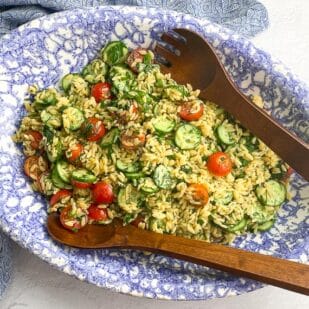
Low FODMAP Orzo Salad
Low FODMAP Orzo Salad might be the perfect summer side-dish. Orzo is rice shaped pasta, typically made from wheat, but in this recipe we are using a low FODMAP gluten-free version. This salad includes colorful, juicy, and crunchy low FODMAP cucumbers and tomatoes. A lemony salad dressing works beautifully with the fresh dill and parsley.
Ingredients:
- 12- ounces (340 g) low FODMAP gluten-free orzo, such as Delallo
- Low FODMAP Lemon Salad Dressing, made with coarse mustard
- 3 small seedless cucumbers, such as Persian cucumbers, sometimes called mini or baby cucumbers (they are about 6-inches/15 cm long, and thin)
- 15 cherry or grape tomatoes, halved
- ¼ cup (8 g) chopped fresh dill
- ¼ cup (8 g) chopped fresh flat-leaf parsley
- ¼ cup (16 g) chopped scallions, green parts only
- 1 tablespoon finely minced lemon zest, preferably made with a Microplane
- Kosher salt
- Freshly ground black pepper
Preparation:
-
Cook the orzo in a large pot of salted water until al dente. Drain well. Place orzo in a big mixing bowl and drizzle with a bit of Low FODMAP Lemon Salad Dressing while it is still warm - just enough to coat.
-
Wash, dry, trim and thinly slice the cucumbers crosswise and add to the now room temp orzo. Add the halved tomatoes, dill, parsley, scallion greens and lemon zest. Add enough salad dressing to coat. Taste and season well with salt and pepper. Allow to sit for 15 minutes for flavors to meld and serve. We much prefer this freshly made. If you want to refrigerate, please bring all the way back to room temperature before serving and be prepared to refresh with a bit more dressing. You can try refrigerating in an airtight container for 24 hours.
Notes:
FODMAP Information
Our recipes are based on Monash University and FODMAP Friendly science.
• Cucumbers: Both Monash University and FODMAP Friendly have lab tested cucumbers. FODMAP Friendly gives them a “Pass” at ½ cup (64 g). Monash states that no FODMAPs were detected upon lab testing and set a serving size at ½ cup (75 g).
• Lemon Juice: Monash University has lab tested lemon juice and it is low FODMAP in 1/2 cup (125 g) amounts.
• Oil: All pure oils are fats and contain no carbohydrates, therefore they contain no FODMAPs.
• Pasta: You have to read labels, but there are many low FODMAP gluten-free brands of pasta available. Use what is called for in individual recipes. Our go-to is rice-based pasta. Monash University and FODMAP Friendly have both tested “gluten-free” pasta, but they do not specify what the pasta was made from. Monash says gluten-free pasta is low FODMAP at 145 g or 1 cup cooked; FODMAP Friendly lab testing suggested 2 cups or 146 g cooked is low FODMAP. Monash has also lab tested pasta made from rice, which they list under “rice stick” and it is low FODMAP at 220 g, which no Moderate or High FODMAP amounts given.
• Tomatoes: Both Monash University and FODMAP Friendly have lab tested common, beefsteak tomatoes. Monash University lab tests have shown no FODMAPs. FODMAP Friendly gives them a “Pass” at ½ cup (75 g) portions. Cherry tomatoes and Plum (Roma) tomatoes have also been tested by Monash and FODMAP Friendly. Both Monash and FODMAP Friendly recommend 75 g of cherry tomatoes as a serving (about 5 or ½ cup) and 75 g of plum or Roma tomatoes, which is about 1 small tomato or ½ cup.
Please always refer to the Monash University & FODMAP Friendly smartphone apps for the most up-to-date lab tested information. As always, your tolerance is what counts; please eat accordingly. The ultimate goal of the low FODMAP diet is to eat as broadly as possible, without triggering symptoms, for the healthiest microbiome.